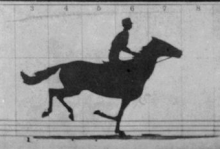Movement sequence

Movement sequences are coordinated , arbitrary sequences of individual movements, which are usually firmly trained. The central nervous processes on which movement processes are based are summarized under the term motor skills .
A period in the walking movement is an everyday example of a movement sequence .
Athletes and musicians train their complex movement sequences (e.g. in gymnastics ) to achieve maximum efficiency with a minimum of physical effort. Well-practiced sequences of movements are "harmonious", that is, they run smoothly and in clear lines.
Forms of disease with disturbed or completely inhibited movements are the apraxia or akinesia .
analysis
At the end of the 19th century, the photographer Eadweard Muybridge was already making anatomical studies of everyday movement sequences in humans and animals by triggering several cameras in quick succession ( series photography ). Around 2000 of these series of recordings were published and are still used today by scientists and artists as training material. The flash photography (especially with stroboscopic flashes ) and later the film expanded the possibilities for the systematic study of motion sequences, such as B. pre-exercised with the zoopraxiscope . Long-term exposures of test persons with lighting elements attached to their joints also provide information about the sequence of movements. According to the current state of the art, motion capture systems allow the creation of spatial models.
Kinematics provides suitable physical-mathematical approaches for the modeling of motion sequences .
See also
- Movement science
- Alexander Technique
- Phase structure of motion sequences
- Movement coordination
- Motion coupling
Web links
- Movement sequences in sport (series of images)
- Biomechanics and motion analysis ( Memento from November 22, 2005 in the Internet Archive )
